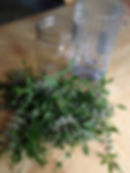Motherwort - Leonurus Cardiaca

Freaked out? Upset? Take a dropperful of motherwort! Distressed about something that might happen? Or might have happened? Take motherwort!



Herb by herb--from yarrow to wormwood, from poke to comfrey--we are making our way through my first aid kit: that little bag of remedies I never leave home without. I keep the same first aid kit handy at home and in the barn, too.
Not only are these herbal remedies simple and safe, they are subversive. Healing ourselves with common weeds found in city as well as country is part of being a radical green witch.
There are two mint goddesses in my first aid kit: motherwort and skullcap. Not that the other mint goddesses are unworthy. Oh, no. The pantheon of mint goddesses is extensive: ranging from radiant rosemary to purple shiso, from bee balm to lemon balm, from sage the savior to lady- like lavender. Indeed, the mint family--now Lamiaceae, formerly Labietae--is replete with herbal and kitchen allies.
I love them all. It's just that I love motherwort and skullcap especially well.
Motherwort (Leonurus cardiaca) is the herb of longevity to the Japanese, who make it into a wine. Chinese and the Russian herbalists also favor motherwort. I use motherwort tincture, made from her fresh flowering tops* tinctured in 100 proof vodka. The finished product smells vaguely like chocolate and tastes a lot better than the fresh or dried plant. Motherwort is a bitter mint, not an aromatic one.
Freaked out? Upset? Take a dropperful of motherwort! Distressed about something that might happen? Or might have happened? Take motherwort! Women with the premenstrual crazies take motherwort. Frenzied children take motherwort. Menopausally mad women take motherwort. Even lovers take motherwort. Spend some time in her lap and you'll come to cherish motherwort's calming ways too.
Motherwort is fast relief for those with menstrual cramps. A 5-10 drop dose, taken at the first twinge of pain and repeated every 10-15 minutes, or as needed, will do the trick for most women. Of course, a cup of ginger tea or a catnip joint will work too. What makes motherwort special is her tonic effect in addition to the pain relief. Motherwort tones the uterine muscle and eventually--usually within four months--eliminates those menstrual cramps for good.
Motherwort is a favorite ally of menopausal women too. A dropperful stops hot flashes, relieves rapid heartbeat, soothes frayed nerves, and helps the tears flow. A dose of 10-15 drops taken just before bed can help ensure deeper sleep. Daily use of 15 drops several times a day can improve vaginal elasticity and bolster libido.
In addition to its health-promoting effects on the uterus, motherwort heals the heart. It is, in fact, one of the world's best heart tonics. Its name means "lion hearted" or "strong hearted." Daily use helps new blood vessels grow to the heart. I call it "a bypass in a bottle." (Yes, motherwort increases vascularization to the uterus as well, so daily--but not occasional--use is contra-indicated for women with endometriosis or fibroids.) A dose of 10-20 drops, taken several times a day, can lower blood pressure, improve heart action, and strengthen electrical activity in the heart.
New research showing that the heart has the same memory cells found in the brain may lead us to another use of motherwort: to help relieve heartache, especially from childhood injuries. Let motherwort ease your bad memories and open you to more joy. Try 5-10 drops before meditating and see what happens.
I don't have menstrual cramps any more. (I never really did, but motherwort was great at relieving that "bowling ball in my belly" sensation I got on the first day of my flow.) I don't even have hot flashes any more. My heart is healthy and my childhood pains resolved. So why is motherwort in my first aid kit? For pain relief!
Whatever your pain--lower back pain, gas pain, tooth pain, almost any pain--motherwort can relieve it. I start with 10-20 drops, and repeat it every 15 minutes until I get relief. Women with chronic fatigue and fibromyalgia respond strongly to motherwort, with pain relief evident in a few hours to a few days.
Motherwort is a very common weed. If you live in the northeast and have a garden, or know of a vacant lot in the city, you probably already have motherwort growing near you. The biggest one I ever saw--eight feet tall at least--was growing in the elephant enclosure at the Buffalo Zoo. Being a mint, motherwort self-sows very freely, but she doesn't spread by means of her perennial roots. If you aren't already blessed with motherwort near you, plant some: Scatter a handful of seeds on top of the earth in the early fall and stand back.
In the spring, when all the baby motherwort plants are starting, I thin them and pour apple cider vinegar over the thinnings. If I have removed an overwintered plant I use her leaves too. Motherwort vinegar is ready to use after six weeks. The taste is yummy and it's loaded with calcium and antioxidant vitamins. Wow.
Skullcap (Scutellaria lateriflora) is related to motherwort, but she is far more shy. To find her, you'll have to go out into the woods. Will you meet me there? I'll be looking for you. We'll go on a skullcap hunt, learn about a more-common herb that can take its place, and have some fun in a thunder storm. Until then, green blessings.
(* The flowering top includes flowers, flower buds, seeds, stalk, and leaves from the top one-third of the plant. I take no more than half of the flowering tops from any plant community.)
********************
This article was written when long cold winters were the norm. Nowadays it is too warm at night to collect sap in March and most sugaring is done in February. ~ Susun